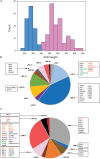Classification and Interactions of LRR Receptors and Co-receptors Within the Arabidopsis Plasma Membrane - An Overview
- PMID: 31057579
- PMCID: PMC6477698
- DOI: 10.3389/fpls.2019.00472
Classification and Interactions of LRR Receptors and Co-receptors Within the Arabidopsis Plasma Membrane - An Overview
Abstract
Receptor kinases (RK) constitute the largest protein kinase family in plants. In particular, members of the leucine-rich repeat-receptor kinases (LRR-RKs) are involved in the perception of various signals at the plasma membrane. Experimental evidence over the past years revealed a conserved activation mechanism through ligand-inducible heterodimer formation: a ligand is recognized by a receptor kinase with a large extracellular domain (ECD). This ligand binding receptor directly interacts with a so-called co-receptor with a small ECD for ligand fixation and kinase activation. A large proportion of LRR-RKs is functionally still uncharacterized and the dynamic complexity of the plasma membrane makes it difficult to precisely define receptor kinase heterodimer pairs and their functions. In this review, we give an overview of the current knowledge of LRR receptor and co-receptor functions. We use ECD lengths to classify the LRR receptor kinase family and describe different interaction properties of ligand-binding receptors and their respective co-receptor from a network perspective.
Keywords: LRR-RKs; co-receptor; extracellular domain lengths; ligand-perceiving; plasma membrane.
Figures


Similar articles
-
Plant Leucine-Rich Repeat Receptor Kinase (LRR-RK): Structure, Ligand Perception, and Activation Mechanism.Molecules. 2019 Aug 25;24(17):3081. doi: 10.3390/molecules24173081. Molecules. 2019. PMID: 31450667 Free PMC article. Review.
-
Biochemical mapping of a ligand-binding domain within Arabidopsis BAM1 reveals diversified ligand recognition mechanisms of plant LRR-RKs.Plant J. 2012 Jun;70(5):845-54. doi: 10.1111/j.1365-313X.2012.04934.x. Epub 2012 Mar 31. Plant J. 2012. PMID: 22321211
-
Leucine-rich repeat receptor kinases in plants: structure, function, and signal transduction pathways.Int Rev Cytol. 2004;234:1-46. doi: 10.1016/S0074-7696(04)34001-5. Int Rev Cytol. 2004. PMID: 15066372 Review.
-
An extracellular network of Arabidopsis leucine-rich repeat receptor kinases.Nature. 2018 Jan 18;553(7688):342-346. doi: 10.1038/nature25184. Epub 2018 Jan 10. Nature. 2018. PMID: 29320478 Free PMC article.
-
Mechanistic basis for the activation of plant membrane receptor kinases by SERK-family coreceptors.Proc Natl Acad Sci U S A. 2018 Mar 27;115(13):3488-3493. doi: 10.1073/pnas.1714972115. Epub 2018 Mar 12. Proc Natl Acad Sci U S A. 2018. PMID: 29531026 Free PMC article.
Cited by
-
BAK-up: the receptor kinase BAK-TO-LIFE 2 enhances immunity when BAK1 is lacking.Stress Biol. 2023 Sep 25;3(1):42. doi: 10.1007/s44154-023-00124-y. Stress Biol. 2023. PMID: 37747566 Free PMC article.
-
Identification and characterization of the LRR repeats in plant LRR-RLKs.BMC Mol Cell Biol. 2021 Jan 28;22(1):9. doi: 10.1186/s12860-021-00344-y. BMC Mol Cell Biol. 2021. PMID: 33509084 Free PMC article.
-
The Phloem Intercalated With Xylem-Correlated 3 Receptor-Like Kinase Constitutively Interacts With Brassinosteroid Insensitive 1-Associated Receptor Kinase 1 and Is Involved in Vascular Development in Arabidopsis.Front Plant Sci. 2022 Jan 11;12:706633. doi: 10.3389/fpls.2021.706633. eCollection 2021. Front Plant Sci. 2022. PMID: 35087541 Free PMC article.
-
Orthology and synteny analysis of receptor-like kinases "RLK" and receptor-like proteins "RLP" in legumes.BMC Genomics. 2021 Feb 10;22(1):113. doi: 10.1186/s12864-021-07384-w. BMC Genomics. 2021. PMID: 33568053 Free PMC article.
-
Macromolecular tool box to elucidate CLAVATA3/EMBRYO SURROUNDING REGION-RELATED-RLK binding, signaling, and downstream effects.J Exp Bot. 2024 Sep 11;75(17):5438-5456. doi: 10.1093/jxb/erae206. J Exp Bot. 2024. PMID: 38717932 Free PMC article.
References
LinkOut - more resources
Full Text Sources
Miscellaneous

